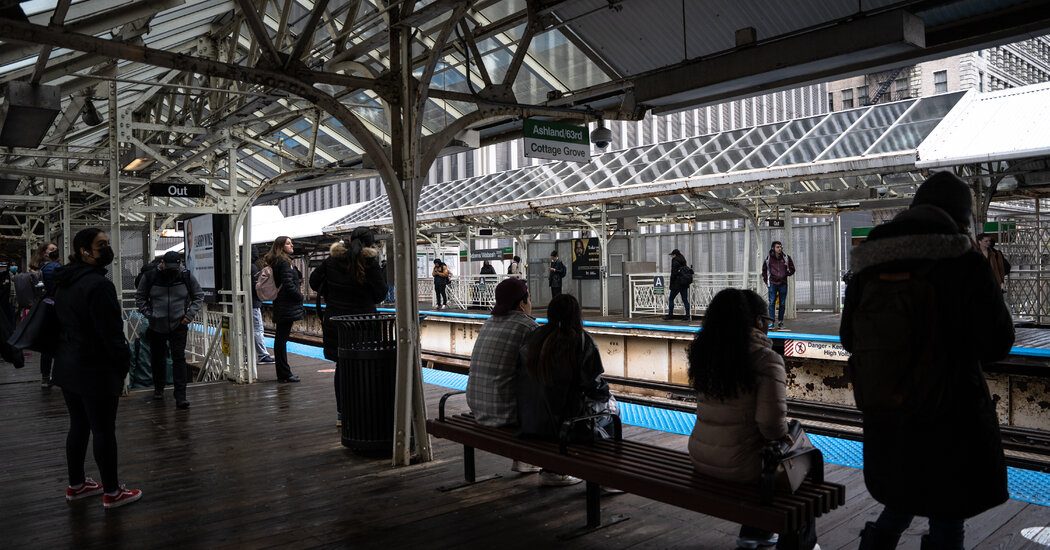
When it comes to the economy, more is usually better.
Bigger job gains, faster wage growth and more consumer spending are all, in normal times, signs of a healthy economy. Growth might not be sufficient to ensure widespread prosperity, but it is necessary — making any loss of momentum a worrying sign that the economy could be losing steam or, worse, headed into a recession.
But these are not normal times. With nearly twice as many open jobs as available workers and companies struggling to meet record demand, many economists and policymakers argue that what the economy needs right now is not more, but less — less hiring, less wage growth and above all less inflation, which is running at its fastest pace in four decades.
Jerome H. Powell, the Federal Reserve chair, has called the labor market “unsustainably hot,” and the central bank is raising interest rates to try to cool it. President Biden, who met with Mr. Powell on Tuesday, wrote in an opinion article this week in The Wall Street Journal that a slowdown in job creation “won’t be a cause for concern” but would rather be “a sign that we are successfully moving into the next phase of recovery.”
“We want a full and sustainable recovery,” said Claudia Sahm, a former Fed economist who has studied the government’s economic policy response to the pandemic. “The reason that we can’t take the victory lap right now on the recovery — the reason it is incomplete — is because inflation is too high.”
But a cooling economy carries its own risks. Despite inflation, the recovery from the pandemic recession has been among the strongest on record, with unemployment falling rapidly and incomes rebounding fastest for those at the bottom. If the recovery slows too much, it could undo much of that progress.
“That’s the needle we’re trying to thread right now,” said Harry J. Holzer, a Georgetown University economist. “We want to give up as few of the gains that we’ve made as possible.”
Economists disagree about the best way to strike that balance. Mr. Powell, after playing down inflation last year, now says reining it in is his top priority — and argues that the central bank can do so without cutting the recovery short. Some economists, particularly on the right, want the Fed to be more aggressive, even at the risk of causing a recession. Others, especially on the left, argue that inflation, while a problem, is a lesser evil than unemployment, and that the Fed should therefore pursue a more cautious approach.
But where progressives and conservatives largely agree is that evaluating the economy will be particularly difficult over the next several months. Distinguishing a healthy cool-down from a worrying stall will require looking beyond the indicators that typically make headlines.
“It’s a very difficult time to interpret economic data and to even understand what’s happening with the economy,” said Michael R. Strain, an economist with the American Enterprise Institute. “We’re entering a period where there’s going to be tons of debate over whether we are in a recession right now.”
Slower job growth could be good (or bad).
The jobs report for May, which the Labor Department will release on Friday, will provide a case study in the difficulty of interpreting economic data right now.
Understand Inflation and How It Impacts You
Ordinarily, one number from the monthly report — the overall jobs added or lost — is enough to signal the labor market’s health. That is because most of the time, the driving force in the labor market is demand. If business is strong, employers will want more workers, and job growth will accelerate. When demand lags, then hiring slows, layoffs mount and job growth stalls.
Right now, though, the limiting factor in the labor market is not demand but supply. Employers are eager to hire: There were 11.4 million job openings at the end of April, close to a record. But there are roughly half a million fewer people either working or actively looking for work than when the pandemic began, leaving employers scrambling to fill available jobs.
The labor force has grown significantly this year, and forecasters expect more workers to return as the pandemic and the disruptions it caused continue to recede. But the pandemic may also have driven longer-lasting shifts in Americans’ work habits, and economists aren’t sure when or under what circumstances the labor force will make a complete rebound. Even then, there might not be enough workers to meet the extraordinarily high level of employer demand.
Most forecasters expect the report on Friday to show that job growth slowed in May. But that number alone won’t reveal whether the mismatch between supply and demand is easing. Slowing job growth coupled with a growing labor force could be a sign that the labor market is coming back into balance as demand cools and supply improves. But the same level of job growth without an increase in the supply of workers could indicate the opposite: that employers are having an even more difficult time finding the help they need.
Many economists say they will be watching the labor force participation rate — the share of the population either working or looking for work — just as closely as the headline job growth figures in coming months.
“One can unambiguously root for higher labor force participation,” said Jason Furman, a Harvard economist who was an adviser to President Barack Obama. “Beyond that, nothing else is unambiguous.”
Wage growth may need to slow.
Another number will be getting a lot of attention from economists, policymakers and investors: wage growth.
Employers have responded to the hot competition for workers exactly the way Econ 101 says they should, by raising pay. Average hourly earnings were up 5.5 percent in April from a year earlier, more than twice the rate they were rising before the pandemic.
Normally, faster wage growth would be good news. Persistently weak pay increases were a bleak hallmark of the long, slow recovery that followed the last recession. But even some economists who bemoaned those sluggish gains at the time say the current rate of wage growth is unsustainable.
“That’s something that we’re used to saying pretty unequivocally is good, but in this case it just raises the risk that the economy is overheating further,” said Adam Ozimek, chief economist of the Economic Innovation Group, a Washington research organization. As long as wages are rising 5 or 6 percent per year, he said, it will be all but impossible to bring inflation down to the Fed’s 2 percent target.
Inflation F.A.Q.
What is inflation? Inflation is a loss of purchasing power over time, meaning your dollar will not go as far tomorrow as it did today. It is typically expressed as the annual change in prices for everyday goods and services such as food, furniture, apparel, transportation and toys.
Fed officials are watching closely for signs of a “wage-price spiral,” a self-reinforcing pattern in which workers expect inflation and therefore demand raises, leading employers to increase prices to compensate. Once such a cycle takes hold, it can be difficult to break — a prospect Mr. Powell has cited in explaining why the central bank has become more aggressive in fighting inflation.
“It’s a risk that we simply can’t run,” he said at a news conference last month. “We can’t allow a wage-price spiral to happen. And we can’t allow inflation expectations to become unanchored. It’s just something that we can’t allow to happen, and so we’ll look at it that way.”
Some economists, especially on the left, say there is little evidence that wage growth is feeding inflation, let alone that a wage-price spiral is developing. They contend that the recent pay gains reflect a rare moment of worker power in the labor market, and that the Fed would be wrong to snuff it out.
But wages, on average, aren’t keeping up with inflation, meaning that many workers are losing ground despite the strong labor market. For workers to prosper, their wages need to be rising after adjusting for inflation — which almost certainly requires inflation to come down.
“What people are feeling is real,” said Darrick Hamilton, an economist at the New School in New York. “A wage increase that’s not as high as the increase in the price of milk does not make you better off.”
Mr. Hamilton argues that the Fed is right to try to rein in inflation, but that it needs to design its policies with the recognition that it will be Black workers, along with other disadvantaged groups, who suffer most if the recovery falters. “The question that we should be asking is who bears the burden” of the Fed’s policies, he said.
Keep an eye on job openings.
Historically, even small increases in the unemployment rate have almost always signaled the start of a recession. Should that relationship hold in the current environment, it suggests that if policymakers want to tame inflation without causing a downturn, they will have to find a way to cool off the labor market without causing a large number of layoffs.
Mr. Powell and other officials argue that is possible, partly because so many jobs are available right now. In a speech in Germany this week, Christopher J. Waller, a Fed governor, argued that as demand slows, employers are likely to start posting fewer jobs before they turn to layoffs. That could result in slower wage growth — since with fewer employers trying to hire, there will be less competition for workers — without a big increase in unemployment.
“I think there’s room right now for inflation to come down a significant amount without unemployment coming up,” said Mike Konczal, an economist at the Roosevelt Institute.
The Fed’s efforts to cool off the economy are already bearing fruit, Mr. Konczal said. Mortgage rates have risen sharply, and there are signs that the housing market is slowing as a result. The stock market has lost almost 15 percent of its value since the beginning of the year. That loss of wealth is likely to lead at least some consumers to pull back on their spending, which will lead to a pullback in hiring. Job openings fell in April, though they remained high, and wage growth has eased.
“There’s a lot of evidence to suggest the economy has already slowed down,” Mr. Konczal said. He said he was optimistic that the United States was on a path toward “normalizing to a regular good economy” instead of the boomlike one it has experienced over the past year.
But the thing about such a “soft landing,” as Fed officials call it, is that it is still a landing. Wage growth will be slower. Job opportunities will be fewer. Workers will have less leverage to demand flexible schedules or other perks. For the Fed, achieving that outcome without causing a recession would be a victory — but it might not feel like one to workers.




